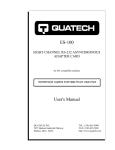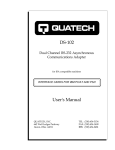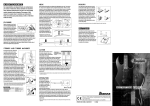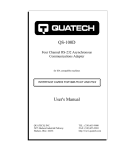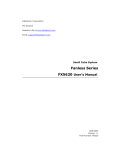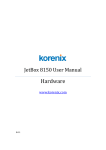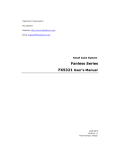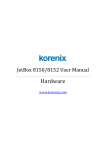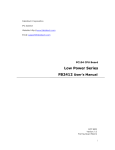Download Quatech ES-100M User`s manual
Transcript
ES-100M / QS-100M Multi-port Asynchronous Communications Adapter User's Manual QUATECH, INC. 662 Wolf Ledges Parkway Akron, Ohio 44311 TEL: (330) 434-3154 FAX: (330) 434-1409 BBS: (330) 434-2481 ES-100 User's Manual Version 2.00 October 1994 P/N. 940-0019-200 WARRANTY INFORMATION Quatech Inc. warrants the ES-100M / QS-100M to be free of defects for one (1) year from the date of purchase. Quatech Inc. will repair or replace any adapter that fails to perform under normal operating conditions and in accordance with the procedures outlined in this document during the warranty period. Any damage that results from improper installation, operation, or general misuse voids all warranty rights. The authors have taken due care in the preparation of this document and any associated software program(s). In no event will Quatech Inc. be liable for damages of any kind, incidental or consequential, in regard to or arising out of the performance or form of the materials presented herein and in the program(s) accompanying this document. No representation is made regarding the suitability of this product for any particular purpose. Quatech Inc. reserves the right to edit or append to this document or the product(s) to which it refers at any time and without notice. Please complete the following information and retain for your records. Have this information available when requesting warranty service. Date of purchase: Model Number: ES-100 / QS-100M Product Description: Multi-port Asynchronous Communications Adapter Serial Number: TABLE OF CONTENTS List of Figures I. II. III. IV. V. VI. VII. VIII. General Information Installation Addressing Ports Interrupt Level (IRQ) Interrupt Sharing Interrupt Status Register External Connections Channel Output Configuration Serial Port Functional Description Accessing the Serial Port Registers Interrupt Enable Register Interrupt Identification Register FIFO Control Register Line Control Register Modem Control Register Line Status Register Modem Status Register Scratchpad Register FIFO Interrupt Mode Operation FIFO Polled Mode Operation Baud Rate Selection Serial Port Functional Description Troubleshooting iii 1 2 5 8 8 8 10 11 14 15 16 16 18 19 20 21 22 22 23 24 25 27 28 LIST OF FIGURES Figure Figure Figure Figure Figure Figure Figure Figure Figure Figure Figure Figure Figure Figure Figure Figure Figure Figure Figure Figure Figure Figure Figure Figure Figure 1. 2. 3. 4. 5. 6. 7. 8. 9. 10. 11. 12. 13. 14. 15. 16. 17. 18. 19. 20. 21. 22. 23. 24. 25. Default address and IRQ settings Diagram of QS-100M / ES-100M Port address map Examination of a serial port base address Serial port base I/O address selection switches Interrupt level (IRQ) selection Enabling the Interrupt Status Register Interrupt Status Register contents Use of DTEs and DCEs in a communications link Cabling requirements for RS-232-C devices QS-100M / ES-100M connector definitions QS-100M / ES-100M output connectors Auxiliary signal configuration jumpers Output connector configuration Serial port register address map for 16450/16550 Interrupt Enable Register bit definitions Interrupt Identification Register bit definitions Interrupt Identification Register bit decoding 16550 FIFO Control Register bit definitions Line Control Register bit definitions Modem Control Register bit definitions Line Status Register bit definitions Modem Status Register bit definitions Input clock frequency options Divisor latch settings for common baud rates 2 3 5 6 7 8 9 9 10 10 11 11 12 13 15 16 17 17 18 19 20 21 22 25 26 I. GENERAL INFORMATION The Quatech, Inc. ES-100M provides eight RS-232 asynchronous serial communication interfaces for IBM-compatible personal computer systems using the 16-bit ISA (Industry Standard Architecture) expansion bus. The QS-100M is a four-port version of the same product (with several blank areas on the circuit card). External connections are made using RJ-11 "phone jack" connectors. This document uses "QS/ES-100M" when information applies to either product. The QS/ES-100M's serial ports are implemented using 16450 Universal Asynchronous Receiver/Transmitters (UARTs). For higher performance, 16550 UARTs can be installed in place of the 16450 UARTs. The 16550 contains a hardware buffer that reduces processing overhead. Software must be aware of the 16550 UART for the device's extra capabilities to be used, otherwise it will act as a 16450 UART. The 16550 is suggested for multitasking environments and for applications involving high data rates. The QS/ES-100M is highly flexible with respect to addressing and interrupt level use. The serial ports are addressed in a contiguous block that can be placed anywhere within the range of 0000 hex to FFFF hex, and available interrupt levels include IRQ2 to IRQ7, IRQ10 to IRQ12, IRQ14, or IRQ15. (Early versions of the QS/ES-100M are limited to IRQ2-7.) All ports on the QS/ES-100M share one interrupt level. A special interrupt status register is provided to allow controlling software to manage the shared interrupt level. The shared interrupt feature minimizes the system resources consumed by the adapter. In order to support the use of the shared interrupt feature of the QS/ES-100M, Quatech has developed device drivers for several popular operating systems and environments. The sales department can be contacted for details on current offerings. Quatech QS-100M/ES-100M User's Manual 1 II. INSTALLATION If the default address and interrupt settings are sufficient, the QS/ES-100M can be quickly installed and put to use. The factory defaults are listed in Figure 1. PORT ADDRESS IRQ Serial 1 300 hex 3 Serial 2 308 hex 3 Serial 3 310 hex 3 Serial 4 318 hex 3 Serial 5 (ES only) 320 hex 3 Serial 6 (ES only) 328 hex 3 Serial 7 (ES only) 330 hex 3 Serial 8 (ES only) 338 hex 3 Figure 1 --- Default address and IRQ settings for QS/ES-100M The outputs of the QS/ES-100M are provided with RJ-11 connectors. See section V of this manual for connector details. 1. If the default settings are correct, skip to step 2, otherwise refer to sections III and IV of this document for detailed information on how to set the address and IRQ level. 2. Turn off the power of the computer system in which the QS/ES-100M is to be installed. 3. Remove the system cover according to the instructions provided by the computer manufacturer. 4. Install the QS/ES-100M in any vacant expansion slot. The board should be secured by installing the Option Retaining Bracket (ORB) screw. 5. Replace the system cover according to the instructions provided by the computer manufacturer. 6. Attach and secure the cable connectors to the desired equipment. 2 Quatech QS-100M/ES-100M User's Manual Figure 2 --- Diagram of QS/ES-100M (SW1, SW2) Set addresses here SW2 J8 J9 J6 J7 J4 J5 J2 J3 (J10) Set IRQ level here QUATECH INC. ES-100 / QS-100M 16450/16550 16450/16550 16450/16550 Shaded parts are not present on the QS-100M. SW1 J1 16450/16550 J10 16450/16550 16450/16550 16450/16550 16450/16550 IRQ 2 IRQ 3 IRQ 4 IRQ 5 IRQ 6 IRQ 7 IRQ 10 IRQ 11 IRQ 12 IRQ 14 IRQ 15 Quatech QS-100M/ES-100M User's Manual 3 J17 J18 J15 J16 J13 J14 J11 J12 (Diagram not to scale) CN1 (This page left blank intentionally.) 4 Quatech QS-100M/ES-100M User's Manual III. ADDRESSING PORTS Setting The Address The base address of the QS/ES-100M is set using the two DIP switch packs. When setting the address selection switches, a switch in the "ON" position specifies that the corresponding address line must be a logic 0 for the port to be selected. Similarly, a switch in the "OFF" position forces the corresponding address line to be a logic 1 for the port to be selected. A full sixteen bit address decode is implemented to reduce the chance of address conflicts with other adapters in the system. The base address of the QS/ES-100M can be set anywhere in the range of 0000 hex to FFFF hex. Each serial port on the QS/ES-100M uses 8 consecutive I/O locations. The ports reside in a contiguous block of I/O space in eight byte increments, for a total of 32 contiguous bytes in the case of the QS-100M, or 64 contiguous bytes in the case of the ES-100M. This is shown in Figure 3. PORT ADDRESS RANGE Serial 1 Base Address + 0 to Base Address + 7 Serial 2 Base Address + 8 to Base Address + 15 Serial 3 Base Address + 16 to Base Address + 23 Serial 4 Base Address + 24 to Base Address + 31 Serial 5 (ES only) Base Address + 32 to Base Address + 39 Serial 6 (ES only) Base Address + 40 to Base Address + 47 Serial 7 (ES only) Base Address + 48 to Base Address + 55 Serial 8 (ES only) Base Address + 56 to Base Address + 63 Figure 3 --- Port address map Quatech QS-100M/ES-100M User's Manual 5 Switch SW1 and the first four positions of switch SW2 select address lines A15 through A6. The fifth position of SW2 selects address line A5 on the QS-100M and is not used on the ES-100M. This reflects the different I/O space requirements of the two products. The remaining address lines, A4 - A0 for the QS-100M, or A5 - A0 for the ES-100M, are used by the UART to select the register being accessed. The sixth position on SW2 is used to enable or disable the interrupt status register (see page 9). Figure 4 shows how the switches on the QS/ES-100M represent the address values for serial ports. This figure can be used to explain the examples shown in Figure 5. A serial port's address is a 16-bit quantity that is most often expressed in four hexadecimal (base 16) digits. A hex digit can hold a value from 0 to 15 (decimal), and is made up of four binary bits given weights of eight, four, two, and one, hence the maximum value of 8+4+2+1 = 15. A possible serial port address is 5220 hex. The example below shows how the hex digits are broken down into binary bits. Binary bits 0 1 0 1 0 0 1 0 0 0 1 0 0 0 0 0 Bit weight 8 4 2 1 8 4 2 1 8 4 2 1 8 4 2 1 Sum of bits 0+4+0+1 0+0+2+0 0+0+2+0 0+0+0+0 Hex digits 5 2 2 0 These address bits are set by the switches. All other bits are considered to be zero. 0 1 0 1 0 0 1 0 0 0 1 0 0 0 0 0 Figure 4 --- Examination of a serial port base address 6 Quatech QS-100M/ES-100M User's Manual Switch on bit = 0 Switch off bit = 1 QS-100M Position 6 of SW2 is used to enable or disable the interrupt status register. Factory default setting --- 0300 hex SW1 SW2 ON 1 2 3 4 5 6 1 2 3 4 5 0 0 0 0 0 0 2 1 0 0 0 (no digits) 0 0 3 0 6 Another Example --- 5AC0 hex SW1 SW2 ON 1 2 3 4 5 6 1 2 3 4 5 0 4 0 1 8 0 2 0 8 4 0 (no digits) C A 5 6 0 ES-100M Position 6 of SW2 is used to enable or disable the interrupt status register. Factory default setting --- 0300 hex SW1 SW2 ON 1 2 3 4 5 6 1 2 3 4 0 0 0 0 0 0 2 1 0 0 (no digits) 0 0 3 0 5 6 Another Example --- 5AC0 hex SW1 SW2 ON 1 2 3 4 5 6 1 2 3 4 0 4 0 1 8 0 2 0 8 4 (no digits) C 0 5 A 5 6 Figure 5 --- Serial port base I/O address selection switches Quatech QS-100M/ES-100M User's Manual 7 IV. INTERRUPT LEVEL (IRQ) IRQ11 IRQ12 IRQ14 IRQ15 10 11 12 13 14 15 16 3 4 5 1 2 6 IRQ10 9 IRQ7 22 IRQ6 21 IRQ5 20 IRQ4 17 18 19 IRQ3 IRQ2 The QS/ES-100M allows the use of any interrupt level in the range IRQ2 to IRQ7, IRQ10 to IRQ12, IRQ14, or IRQ15, selected using jumper pack J10. (Early versions of the QS/ES-100M are limited to IRQ2-7.) In Figure 6, the factory default setting of IRQ3 is shown. To select a different IRQ, move the jumper to the appropriate position on J10. 7 8 J10 --- Default is IRQ 3 Figure 6 --- Interrupt level (IRQ) selection Interrupt Sharing All ports on the QS/ES-100M share the same interrupt level. In addition, an interrupt sharing circuit allows the QS/ES-100M to share its interrupt with another Quatech adapter supporting sharable interrupts. In either case, the software driving the serial ports must determine which port or ports are requesting service when an interrupt is generated. The QS/ES-100M signals a hardware interrupt when any port requires service. The interrupt signal is maintained until no port requires service. Because the ISA bus is edge-sensitive, this behavior forces the interrupt service routine to ensure that all ports are checked before exiting. A way to do this is to poll each port until an interrupting port is found. After servicing the port, all ports should be checked again. If any interrupting port is left unserviced the QS/ES-100M will be unable to signal any further interrupts. Interrupt Status Register The QS/ES-100M is equipped with an interrupt status register which can be used to simplify the servicing of shared interrupts. If this feature is enabled, the read-only interrupt status register is accessed in place of the scratchpad of any given UART at base address + 7. Virtually no commercially available software makes use of the scratchpad register. 8 Quatech QS-100M/ES-100M User's Manual The choice of using the interrupt status register or the UART scratchpads (factory default) is made using position 6 of switch SW2 as shown in Figure 7. SW2 SW2 ON ON 1 2 3 4 5 1 6 2 3 4 5 6 Scratchpad Register (factory default) Interrupt Status Register Slide position 6 of SW2 toward the top of the QS/ES-100M to enable the interrupt status register, or toward the bottom of the QS/ES-100M to disable it. Figure 7 --- Enabling the Interrupt Status Register When a hardware interrupt occurs, reading the interrupt status register will return the interrupt status of the entire QS/ES-100M, as shown in Figure 8. Individual bits are cleared as the interrupting ports are serviced. The interrupt service routine must ensure that the interrupt status register reads zero before exiting, or the QS/ES-100M will be unable to signal subsequent interrupts. If the QS/ES-100M is of revision level 'B' or higher, an I/O write to the interrupt status register will cause another hardware interrupt to be generated if the interrupt status register is non-zero. The value written is ignored and has no effect on the contents of the interrupt status register. Software written to take advantage of this retriggering will be transparent to an older revision of the QS/ES-100M. BIT DESCRIPTION 7 (MSB) Serial 8 --- 1 if interrupt pending (always 0 on QS-100M) 6 Serial 7 --- 1 if interrupt pending (always 0 on QS-100M) 5 Serial 6 --- 1 if interrupt pending (always 0 on QS-100M) 4 Serial 5 --- 1 if interrupt pending (always 0 on QS-100M) 3 Serial 4 --- 1 if interrupt pending 2 Serial 3 --- 1 if interrupt pending 1 Serial 2 --- 1 if interrupt pending 0 Serial 1 --- 1 if interrupt pending Figure 8 --- Interrupt Status Register contents Quatech QS-100M/ES-100M User's Manual 9 V. EXTERNAL CONNECTIONS RS-232-C devices are classified by their function as either Data Terminal Equipment (DTE) or Data Communication Equipment (DCE). Generally, data terminal equipment is defined as the communication source and data communication equipment is defined as the device that provides a communication channel between two DTE-type devices. Modem Terminal DTE RS-232-C DCE Telephone line Terminal Modem RS-232-C DCE DTE Figure 9 --- Use of DTEs and DCEs in a communications link DTE- and DCE-type devices have complementary pinouts to allow terminals and modems to be connected directly using a one-to-one cable as shown in Figure 10. In many applications, DCEs are unnecessary, and in these cases a cable called a "null modem cable" or "modem eliminator cable" is used to directly connect two DTE-type devices. A typical null modem cable is also shown in Figure 10. (3) (2) (4) (5) (20) (6) (8) (22) (7) RxD TxD RTS CTS DTR DSR DCD RI GND TxD RxD CTS RTS DSR DTR DCD RI GND Typical DTE-to-DCE cable (3) (2) (4) (5) (20) (6) (8) (22) (7) (3) (2) (4) (5) (20) (6) (8) (22) (7) RxD TxD RTS CTS DTR DSR DCD RI GND RxD TxD RTS CTS DTR DSR DCD RI GND (3) (2) (4) (5) (20) (6) (8) (22) (7) Typical DTE-to-DTE null modem cable Figure 10 --- Cabling requirements for RS-232-C devices (cables using 25-pin connectors shown) 10 Quatech QS-100M/ES-100M User's Manual Channel Output Configuration The QS/ES-100M connects to peripheral equipment through RJ-11 connectors, or using the optional adapter cables, male D-25 connectors. When the RJ-11 connector is converted to a D-25 connector, the conversion cable must be assembled with respect to either a DTE or DCE configuration. The standard serial port connections are listed in Figure 11. RS-232 Signal Description DTE connection DCE connection RJ-11 D-25 RJ-11 D-25 AuxIn (CTS) (DSR) 1 5 6 1 4 20 Transmit Data (TxD) 2 2 2 3 Chassis Ground Carrier Detect 3 1 8 3 (DCD) 1 8 4 7 4 7 Signal Ground Receive Data (RxD) 5 3 5 2 AuxOut (DTR) (RTS) 6 20 4 6 6 5 Figure 11 --- QS/ES-100M connector definitions (Top of board) 1 13 25 12 24 2 11 23 10 22 3 9 21 8 4 20 7 19 1 2 3 4 5 6 6 5 18 5 17 RJ-11 connector pinout 4 6 16 3 15 7 8 2 14 1 D-25 connector (using adapter cable) RJ-11 connectors in CN1 (5-8 present on ES-100M only) Figure 12 --- QS/ES-100M output connectors Quatech QS-100M/ES-100M User's Manual 11 The AUXIN and AUXOUT signals on the RJ-11 connector must be determined as well. AUXIN may be selected to be either CTS or DSR. AUXOUT may be selected to be either RTS or DTR. The decision of which signals to use is made separately for each channel. Figure 13 --- Auxiliary signal configuration jumpers. 12 Quatech QS-100M/ES-100M User's Manual A feature available on the ES/QS-100M revision B and newer is the ability to input the carrier detect (DCD) signal from the RJ-11 connector. When shipped from the factory, the ES/QS-100M is configured for compatibility with revision 'A' of the adapter as shown in Figure 14(A) below. In this configuration, pin 3 of the RJ-11 is connected to chassis ground i.e. the frame of the PC. Carrier Detect (DCD) Chassis Ground For applications requiring the carrier detect signal, pin 3 of the RJ-11 connector may be configured to input DCD in place of the chassis ground connection. The decision to connect pin 3 to chassis ground or DCD may be made on a per channel basis using jumpers J11 through J18. Figure 14 --- Output connector configuration. Quatech QS-100M/ES-100M User's Manual 13 VI. SERIAL PORT FUNCTIONAL DESCRIPTION This section contains information intended for advanced users planning to do custom programming with the QS/ES-100M. The information presented here is a technical description of the interface to the 16450 or 16550 UART. The 16450 UART is an improved functional equivalent of the 8250 UART, performing serial-to-parallel conversion on received data and parallel-to-serial conversion on output data. Designed to be compatible with the 16450, the 16550 UART enters character (non-FIFO) mode on reset. In this mode, the 16550 appears as a 16450 to application software. An additional mode, FIFO mode, can be invoked through software to reduce CPU overhead. FIFO mode increases performance by providing two 16-byte hardware buffers, one for transmit and one for receive. This can reduce the frequency of interrupts issued to the CPU by the UART. Other features of the 16450 and 16550 include: Programmable baud rate, character length, parity, and number of stop bits. Automatic control of start, stop, and parity bits. Independent and prioritized interrupts. Transmit clock output / receive clock input. The QS/ES-100M's serial ports are controlled by 16450 or 16550 UARTs. The serial ports will generate interrupts in accordance with the bits set in the interrupt enable register of the UARTs. In order to maintain compatibility with earlier personal computer systems, the user-defined output OUT2 is used as an external interrupt enable and must be set active for interrupts to be generated. OUT2 is accessed through the UART's MODEM control register. The following pages provide a brief summary of the internal registers available within the 16450 and 16550 UARTs. Registers and functions specific to the 16550 will be indicated with boldface italic notations. 14 Quatech QS-100M/ES-100M User's Manual Accessing The Serial Port Registers Figure 15 lists the address map for the 16450 and 16550 UARTs. Each register can be accessed by reading from or writing to the proper I/O address. This I/O address is determined by adding an offset to the base address set for the particular serial port. The base address is set using DIP switches on the QS/ES-100M (see section III). Notice that two locations access different registers depending on whether an I/O read or I/O write is attempted. Address [base+0] accesses the receive buffer on an I/O read, or the transmit buffer on an I/O write. Address [base+2] accesses the Interrupt Identification register on an I/O read or the FIFO control register (16550 only) on an I/O write. Also, notice that if address [base+0] or [base+1] is used with the DLAB bit from the Line Control Register set to '1', the baud rate divisor latches are accessed. NOTE: All figures displaying bitmapped registers are formatted such that bit 7 is the high-order bit. UART Addressing Register Description DLAB I/O Address 0 Base + 0 Receive buffer (read) Transmit holding register (write) 0 Base + 1 Interrupt enable X Base + 2 Interrupt identification (read) (16450 and 16550) FIFO control (write) (16550 only) X Base + 3 Line control X Base + 4 MODEM control X Base + 5 Line status X Base + 6 MODEM status X Base + 7 Scratchpad 1 Base + 0 Baud rate divisor latch (LSB) * 1 Base + 1 Baud rate divisor latch (MSB) * (X = don't care) * DLAB in Line Control Register must be set to access baud rate divisor latch. Figure 15 --- Serial port register address map for 16450/16550 UART Quatech QS-100M/ES-100M User's Manual 15 Interrupt Enable Register This register is located at I/O address [base+1]. It enables the five types of UART interrupts. Interrupts can be totally disabled by setting all of the enable bits in this register to a logic 0. Setting any bit to a logic 1 enables that particular interrupt. BIT DESCRIPTION 7 0 --- reserved 6 0 --- reserved 5 0 --- reserved 4 0 --- reserved 3 EDSSI --- MODEM Status Interrupt: When set (logic 1), enables interrupt on clear to send, data set ready, ring indicator, and data carrier detect. 2 ELSI --- Receiver Line Status Interrupt: When set (logic 1), enables interrupt on overrun, parity, framing errors, and break indication. 1 ETBEI --- Transmitter Holding Register Empty Interrupt: When set (logic 1), enables interrupt on transmitter holding register empty. 0 ETBEI --- Received Data Available Interrupt: When set (logic 1), enables interrupt on received data available. For 16550 FIFO mode, interrupts are also enabled for receive FIFO trigger level reached and for receive timeout. Figure 16 --- Interrupt Enable Register bit definitions Interrupt Identification Register This read-only register is located at I/O address [base+2]. When this register is read, the UART freezes all interrupts and indicates the highest priority interrupt. During this time, new interrupts are detected by the UART, but are not reported in this register until the access completes. For the 16550 only, this register can be used to indicate whether the FIFO mode is engaged by examining bits 6 and 7. 16 Quatech QS-100M/ES-100M User's Manual BIT DESCRIPTION 7 FFE --- FIFO enable: (16550 only) When logic 1, indicates FIFO mode enabled. Always logic 0 for the 16450. 6 FFE --- FIFO enable: (16550 only) When logic 1, indicates FIFO mode enabled. Always logic 0 for the 16450. 5 0 --- reserved 4 0 --- reserved 3 IID2 --- 2 IID1 --- 1 IID0 --- 0 IP --- Interrupt pending: When logic 0, indicates that an interrupt is pending and the contents of the interrupt identification register may be used to determine the interrupt source. See Figure 18. Interrupt Identification: Indicates highest priority interrupt pending if any. See Figure 18. NOTE: IID2 is always a logic 0 on the 16450 or in non-FIFO mode on the 16550. Figure 17 --- Interrupt Identification Register bit definitions Figure 18 gives the detail of the IIDx bits in the Interrupt Identification Register. These bits are examined to determine the source of an interrupt. IIDx bits IP Priority 2 1 Interrupt Type 0 don't care 1 N/A None 0 1 1 0 1st Receiver Line Status: Indicates overrun, parity, framing errors or break interrupts. The interrupt is cleared by reading the line status register. 0 1 0 0 2nd Received Data Ready (16450 or 16550): Indicates receive data available. The interrupt is cleared by reading the receive buffer. In 16550 FIFO mode, indicates the receiver FIFO trigger level has been reached. The interrupt is reset when the FIFO drops below the trigger level. 1 1 0 0 2nd Character Timeout (16550 FIFO mode only): Indicates no characters have been removed from or input to the receiver FIFO for the last four character times and there is data present in the receiver FIFO. The interrupt is cleared by reading the receiver FIFO. 0 0 1 0 3rd Transmitter Holding Register Empty: Indicates the transmitter holding register is empty. The interrupt is cleared by reading the interrupt identification register or writing to the transmitter holding register. (Indicates transmit FIFO empty for 16550.) 0 0 0 0 4th MODEM Status: Indicates clear to send, data set ready, ring indicator, or data carrier detect have changed state. The interrupt is cleared by reading the MODEM status register. Figure 18 --- Interrupt Identification Register bit decoding Quatech QS-100M/ES-100M User's Manual 17 Fifo Control Register (16550 Only) This register, which applies only to the 16550 UART, is a write-only register located at I/O address [base+2]. It is used to enable the FIFO mode, clear the FIFOs, set the threshold level for the receive FIFO to generate interrupts, and to set the mode under which the device uses DMA. Note that DMA mode is NOT supported by the QS/ES-100M. BIT DESCRIPTION 7 RXT1 --- 6 RXT0 --- 5 0 --- reserved 4 0 --- reserved 3 DMAM --- DMA mode select (16550 only): When set (logic 1), RxRDY and TxRDY change from mode 0 to mode 1 for DMA transfers. (DMA mode is not supported on the QS/ES-100M.) 2 XRST --- Transmit FIFO reset (16550 only): When set (logic 1), all bytes in the transmitter FIFO are cleared and the counter is reset. The shift register is not cleared. XRST is self-clearing. 1 RRST --- Receive FIFO reset (16550 only): When set (logic 1), all bytes in the receiver FIFO are cleared and the counter is reset. The shift register is not cleared. RRST is self-clearing. 0 FE --- FIFO enable (16550 only): When set (logic 1), enables transmitter and receiver FIFOs. When cleared (logic 0), all bytes in both FIFOs are cleared. This bit must be set when other bits in the FIFO control register are written to or the bits will be ignored. Receiver FIFO Trigger Level (16550 only): Determines the trigger level for the receiver FIFO interrupt RXT0 Receiver FIFO trigger level (bytes) RXT1 0 0 1 0 1 4 1 0 8 1 1 14 Figure 19 --- 16550 FIFO Control Register bit definitions 18 Quatech QS-100M/ES-100M User's Manual Line Control Register This register is located at I/O address [base+3]. It is used for specifying the format of the asynchronous serial data to be processed by the UART, and to set the Divisor Latch Access Bit (DLAB) allowing access to the baud rate divisor latches. BIT DESCRIPTION 7 DLAB --- Divisor latch access bit: DLAB must be set to logic 1 to access the baud rate divisor latches. DLAB must be set to logic 0 to access the receiver buffer, transmitting holding register and interrupt enable register. 6 BKCN --- Break control: When set (logic 1), the serial output (SOUT) is forced to the spacing state (logic 0). 5 STKP --- Stick parity: Forces parity to logic 1 or logic 0 if parity is enabled. 4 EPS --- Even parity select: Selects even or odd parity if parity is enabled. 3 PEN --- Parity enable: Enables parity on transmission and verification on reception. 2 STB --- Number of stop bits: Sets the number of stop bits STB 0 transmitted. 0 0 0 1 1 1 1 1 WLS1 --- 0 WLS0 --- STKP x 0 0 1 1 EPS x 0 1 0 1 PEN 0 1 1 1 1 PARITY None Odd Even Logic 1 Logic 0 WLS1 WLS0 WORD LEN STOP BITS 0 0 5 bits 1 0 1 6 bits 1 1 0 7 bits 1 1 1 8 bits 1 0 0 5 bits 1.5 0 1 6 bits 2 1 0 7 bits 2 1 1 8 bits 2 Word length select: Determines the number of bits per transmitted word. Figure 20 --- Line Control Register bit definitions Quatech QS-100M/ES-100M User's Manual 19 Modem Control Register This register is located at I/O address [base+4], and is used to control the interface with the modem or device used in place of a modem. This register allows the states of the "modem control signals" to be changed. These are DTR (Data Terminal Ready) and RTS (Request To Send). It is also possible to place the UART in a loopback mode for testing. Finally, the user-defined outputs OUT1 and OUT2 are controlled from this register. The QS/ES-100M handles the OUT1 and OUT2 signals in the manner appropriate for maintaining compatibility with standard PC serial ports: The OUT1 output is not connected. The OUT2 output is used to globally enable interrupts to the computer. It should be active at all times if interrupts are being used. BIT DESCRIPTION 7 0 --- reserved 6 0 --- reserved 5 0 --- reserved 4 LOOP --- Loopback enable: When set (logic 1), the transmitter shift register is connected directly to the receiver shift register. The MODEM control inputs are internally connected to the MODEM control outputs and the outputs are forced to the inactive state. All characters transmitted are immediately received to verify transmit and receive data paths. Transmitter and receiver interrupts still operate normally. MODEM control interrupts are available but are now controlled through the MODEM control register. 3 OUT2 --- Output 2: When this bit is set (logic 1), the OUT2 output is forced active to a logic 0. When cleared (logic 0), the OUT2 output is forced inactive to a logic 1. Used for interrupt enable on the QS/ES-100M. 2 OUT1 --- Output 1: When this bit is set (logic 1), the OUT1 output is forced active to a logic 0. When cleared (logic 0), the OUT1 output is forced inactive to a logic 1. Not connected on the QS/ES-100M. 1 RTS --- Request to send: When this bit is set (logic 1), the RTS output is forced active to a logic 0. When cleared (logic 0), the RTS output is forced inactive to a logic 1. 0 DTR --- Data terminal ready: When this bit is set (logic 1), the DTR output is forced active to a logic 0. When cleared (logic 0), the DTR output is forced inactive to a logic 1. Figure 21 --- Modem Control Register bit definitions 20 Quatech QS-100M/ES-100M User's Manual Line Status Register This register is located at I/O address [base+5]. It is used to provide various types of status information concerning the data transfer. As Figure 22 shows, the Line Status Register indicates several types of errors, an empty transmit buffer, a ready receive buffer, or a break on the receive line. BIT DESCRIPTION 7 FFRX --- Error in RCVR FIFO (16550 FIFO mode only): Always logic 0 in 16450 or 16550 non-FIFO mode. Indicates one or more parity errors, framing errors, or break indications in the receiver FIFO. FFRX is reset by reading the line status register. 6 TEMT --- Transmitter empty: Indicates the transmitter holding register or FIFO (16550) AND the transmitter shift register are empty and are ready to receive new data. TEMT is reset by writing a character to the transmitter holding register. 5 THRE --- Transmitter holding register empty: Indicates the transmitter holding register or FIFO (16550) is empty and it is ready to accept new data. THRE is reset by writing data to the transmitter holding register. 4 BI --- Break interrupt: Indicates the receive data input has been in the spacing state (logic 0) for longer than one full word transmission time. In 16550 FIFO mode, only one zero character is loaded into the FIFO and transfers are disabled until the serial data input goes to the mark state (logic 1) and a valid start bit is received. 3 FE --- Framing error: Indicates the received character had an invalid stop bit. The stop bit following the last data or parity bit was a 0 bit (spacing level). 2 PE --- Parity error: Indicates that the received data does not have the correct parity. 1 OE --- Overrun error: Indicates the receive buffer was not read before the next character was received and the character is destroyed. In 16550 FIFO mode, indicates the receive FIFO is full and another character has been shifted in. The character in the shift register is destroyed but is not transferred to the FIFO. 0 DR --- Data ready: Indicates data is present in the receive buffer or FIFO (16550). DR is reset by reading the receive buffer register or receiver FIFO. Figure 22 --- Line Status Register bit definitions Bits BI, FE, PE, and OE are the sources of receiver line status interrupts. The bits are reset by reading the line status register. In 16550 FIFO mode, these bits are associated with a specific character in the FIFO and the exception is revealed only when that character reaches the top of the FIFO. Quatech QS-100M/ES-100M User's Manual 21 Modem Status Register This register is located at I/O address [base+6]. It reports on the status of signals coming from the modem or equipment used in place of a modem. It allows the current states of "modem control signals" to be sensed. These signals include the DCD (Data Carrier Detect), RI (Ring Indicator), DSR (Data Set Ready), and CTS (Clear To Send). The Modem Status Register also provides change information for each of these signals. When a modem control signal changes state, the appropriate change bit is set to logic 1. The change bits (3, 2, 1, and 0) are reset to logic 0 whenever the Modem Status Register is read. A modem status interrupt is generated whenever any of bits 3, 2, 1 or 0 is set by the UART to a logic 1. BIT DESCRIPTION 7 DCD --- Data carrier detect: Complement of the DCD input. 6 RI --- Ring indicator: Complement of the RI input. 5 DSR --- Data set ready: Complement of the DSR input. 4 CTS --- Clear to send: Complement of the CTS input. 3 DDCD --- Delta data carrier detect: Indicates the Data Carrier Detect input has changed state. Cleared when this register is read. 2 TERI --- Trailing edge ring indicator: Indicates the Ring Indicator input has changed from a low to a high state. Cleared when this register is read. 1 DDSR --- Delta data set ready: Indicates the Data Set Ready input has changed state. Cleared when this register is read. 0 DCTS --- Delta clear to send: Indicates the Clear to Send input has changed state. Cleared when this register is read. Figure 23 --- Modem Status Register bit definitions Scratchpad Register This register is located at I/O address [base+7]. It is not used by the 16450 or 16550. It may be used by the programmer for temporary data storage. The Scratchpad Register is eight bits wide and can be read or written. 22 Quatech QS-100M/ES-100M User's Manual FIFO Interrupt Mode Operation (16550 UART Only) When The Receiver Fifo And Receiver Interrupts Are Enabled: 1. The receive data interrupt is issued when the receive FIFO reaches the trigger level. The interrupt is cleared as soon as the receive FIFO falls below the trigger level. 2. The Interrupt Identification Register's receive data available indicator is set and cleared along with the receive data interrupt when the receive FIFO falls below the trigger level. 3. The data ready indicator is set as soon as a character is transferred into the receiver FIFO and is cleared when the FIFO is empty. 4. A FIFO timeout interrupt will occur if the receive FIFO contains at least one character, at least four character-times have passed since receipt of the last character, and the last read of the FIFO by the CPU was done more than four character-times ago. 5. Timeout interrupts are cleared when a read of the receive FIFO is done. 6. The receive FIFO timeout timer is reset whenever a new character is received into the FIFO or a read of the FIFO is done. When The Transmit Fifo And Transmit Interrupts Are Enabled: 1. The transmitter holding register empty interrupt occurs when the transmit FIFO is empty, and is cleared when a character is written to the FIFO or when the Interrupt Identification Register is read. 2. Transmitter FIFO empty indications are delayed by one character-time less the last stop bit time when the transmitter holding register is empty and there have not been at least two bytes together in the transmit FIFO since the last time the transmitter holding register was empty. 3. The first transmitter interrupt after enabling the FIFO mode will be immediate if that interrupt is enabled. Quatech QS-100M/ES-100M User's Manual 23 FIFO Polled Mode Operation (16550 UART Only) The receiver and transmitter are operated independently, which would allow either or both to be used in a polled mode rather than using interrupts to determine when the UART needs to be serviced. To use the UART in a polled mode, the software is responsible for continuously checking for the conditions that normally cause interrupts to occur. This would be done using the Line Status Register. 1. The Data Ready bit will be set to logic 1 whenever there is at least one byte in the receive FIFO. 2. Errors can be detected using the various error bits. 3. The Transmitter Holding Register Empty bit can be used to determine when the transmit FIFO is empty. 4. The Transmitter Empty bit indicates that the transmitter shift register is empty as well as the transmit FIFO being empty. 5. Trigger levels and FIFO timeouts do not apply. Both FIFOs are fully capable of holding multiple characters at any time. 24 Quatech QS-100M/ES-100M User's Manual Baud Rate Selection The 16450 or 16550 UART determines the baud rate of the serial output using a combination of the clock input frequency and the value written to the divisor latches. Standard personal computer serial interfaces use an input clock of 1.8432 MHz. To increase versatility, the QS/ES-100M uses an 18.432 MHz crystal and a frequency divider circuit to produce the standard clock frequency. Jumper block J1 is used to set the frequency input to the UART. It may be connected to divide the clock input by 1, 2, 5, or 10. A table of baud rates available using the 1.8432 MHz input is given in Figure 25. For compatibility with standard serial ports, J1 should be configured to divide by 10 as shown in Figure 24(d). Divide-by-1 input clock (A) Divide-by-2 input clock (B) Divide-by-5 input clock (C) Divide-by-10 input clock Factory default (D) Figure 24 --- Input clock frequency options Quatech QS-100M/ES-100M User's Manual 25 DESIRED BAUD RATE DIVISOR LATCH VALUE ERROR BETWEEN DESIRED AND ACTUAL VALUES (%) 50 2304 - 75 1536 - 110 1047 0.026 150 768 - 300 384 - 600 192 - 1200 96 - 1800 64 - 2000 58 0.69 2400 48 - 3600 32 - 4800 24 - 7200 16 - 9600 12 - 19200 6 - 38400 3 - 56000 2 2.86 Figure 25 --- Divisor Latch settings for common baud rates using 1.8432 MHz input clock 26 Quatech QS-100M/ES-100M User's Manual VII. SPECIFICATIONS Bus interface: Industry Standard Architecture (ISA) 16-bit bus IBM PC-ATTM compatible Dimensions: Serial ports Number of ports: 13.4" x 4.2" QS-100M --- four ports ES-100M --- eight ports Controllers: 16450 (16550 optional) Interface: RJ-11 connector Male D-25 connector (using optional adapter cables) Transmit drivers: Receive buffers: MC1488 or compatible MC1489 or compatible I/O Address range: Interrupt levels: 0000H - FFFFH IRQ2 to IRQ7 IRQ10 to IRQ12, IRQ14, IRQ15 Power requirements QS-100M: +5 volts: +12 volts: -12 volts: 379 mA typ, 448 mA max 38 mA typ, 46 mA max 36 mA typ, 43 mA max ES-100M: +5 volts: +12 volts: -12 volts: 439 mA typ, 509 mA max 76 mA typ, 88 mA max 72 mA typ, 82 mA max Quatech QS-100M/ES-100M User's Manual 27 VIII. TROUBLESHOOTING Listed here are some common problems and frequent causes of those problems. Suggestions for corrective action are given. If the information here does not provide a solution, contact Quatech Customer Service for technical support. Any unauthorized repairs or modifications will void the QS/ES-100M's warranty. Computer will not boot up. 1. Is the QS/ES-100M properly inserted? Remove the card and try again. Perhaps try a different expansion slot. 2. Is the base address correctly set? Check for address conflicts with other devices in the system. Remember that the QS-100M requires 32 bytes of I/O space and the ES-100M requires 64 bytes of I/O space. Set a different address if necessary. 3. The QS/ES-100M may be defective. Contact Quatech Customer Service for instructions. Cannot communicate with other equipment. 1. Are the cable connections correct? attached? Are the cables securely 2. Are the base address and interrupt level (IRQ) correctly set? Check for address and IRQ conflicts with other devices in the system. Change the settings if necessary. 3. If you are trying to communicate with a DTE, a null-modem cable may be required. 4. If possible, use a loopback connector to test the port. This connector needs to connect the following sets of signals on a D-25 connector: TxD and RxD (pins 2 and 3) RTS and CTS (pins 4 and 5) DCD, DTR, DSR, and RI (pins 8, 20, 6 and 22) 28 Quatech QS-100M/ES-100M User's Manual

































